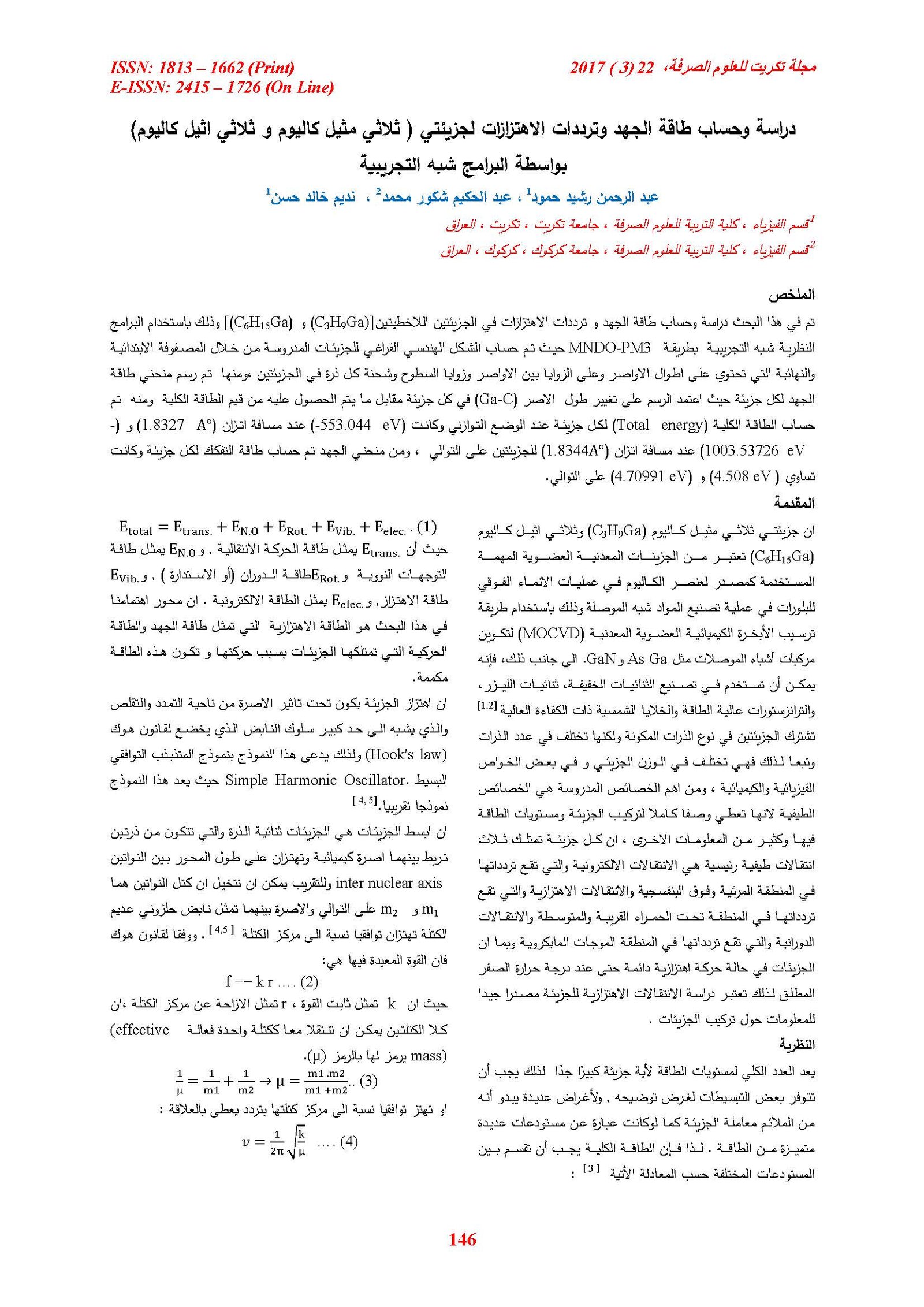STUDYING AND CALCULATION OF THE POTENTIAL ENERGY FOR TWO OF MOLECULES [TRIMETHYL GALLIUM AND TRIETHYL GALLIUM,] BY SEMI EMPIRICAL PROGRAMS
Main Article Content
Abstract
In this research, the potential energy and vibration frequencies for two of an non-liner molecules [ (C3H9Ga) and (C6H15Ga)] have been studied and calculated by using the semi-empirical theoretical programs in method (MNDO/PM3) where the geometric space shape of two molecules has been calculated by using initial and final matrices that include bonds length, the angle between bonds, dihedral angles and the charge of each atom in the two molecules, which have been drawing a curved of potential energy per molecule where the drawing was adopted to change the length of the bond (Ga-C) in the each molecule compared to what is obtained from the values of energy and it was total energy calculate for each molecule at equilibrium distance was (-553.044 eV) at equilibrium distance (1.8327 ) and (-1003.53726 eV) at equilibrium distance (1.8344 ) for the two molecules, respectively, and from the carve of the potential energy was the spectroscopy dissociation energy per molecule account it was equal to (4.508 eV) and (4.70991 eV) respectively .
Article Details

This work is licensed under a Creative Commons Attribution 4.0 International License.
Tikrit Journal of Pure Science is licensed under the Creative Commons Attribution 4.0 International License, which allows users to copy, create extracts, abstracts, and new works from the article, alter and revise the article, and make commercial use of the article (including reuse and/or resale of the article by commercial entities), provided the user gives appropriate credit (with a link to the formal publication through the relevant DOI), provides a link to the license, indicates if changes were made, and the licensor is not represented as endorsing the use made of the work. The authors hold the copyright for their published work on the Tikrit J. Pure Sci. website, while Tikrit J. Pure Sci. is responsible for appreciate citation of their work, which is released under CC-BY-4.0, enabling the unrestricted use, distribution, and reproduction of an article in any medium, provided that the original work is properly cited.
References
1) Shenai-Khatkhate, D. V.; Goyette, R. J.; Dicarlo, R. L. Jr; Dripps, G. "Environment, health and safety issues for sources used in MOVPE growth of compound semiconductors". Journal of Crystal Growth 272 (1–4): 816–21. (2004). Bibcode:2004JCrGr.272..816S. doi:10.1016/j.jcrysgro.2004.09.007
2) Akzo Nobel HPMO: triethylgallium, accessed on 21 Februar 2014th
5) Peter F. Bernath, "Molecular Spectroscopy and Structure", Departments of Chemistry and Physics, University of Waterloo, Ontario, Canada N2L 3G1
6) G.M Barrow, "Introduction To Molecular Spectroscopy" Mc Graw-Hill, (1962).
471 - 478 ، 20108) Catherine .E. Housecraft & Sharpe, “Inorganic Chemistry”, 3rd
9) Elsevier," Introductory Raman Spectroscopy", (Second edition), 2003
10) Norm and M. Laurendeau, "Statistical. Thermodynamics, Fundamentals and Applications", Purdue University, 2005
11) Walter. S. Struve, " fundamentals of molecular spectroscopy "Department of Chemistry, Iowa State University, Ames, Iowa,1988
15) Laura Frank Fort and Karl Sohlberg, "semi empirical study of a PH-switchable [2]-rotaxane ''J. OF Molec. Struct. Theo. Chem.'', 621, 253-260, (2003)
